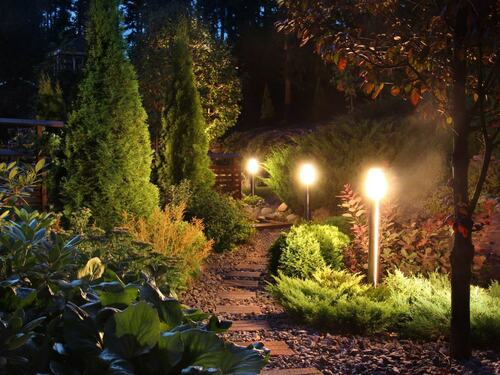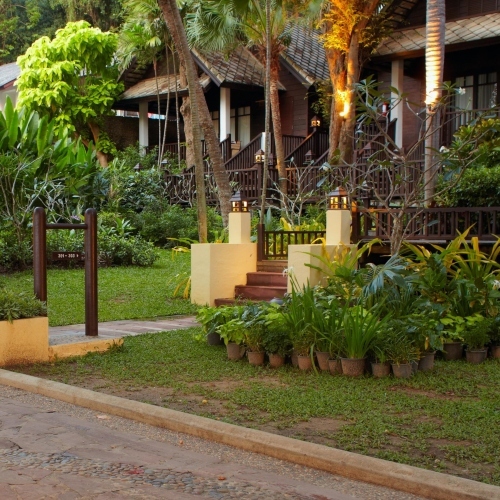Utilizing Landscaping Lighting for Your Trees
Introduction
Landscape lighting is a powerful tool for transforming your outdoor space, and when it comes to showcasing the natural beauty of your trees, it can work wonders. Properly illuminated trees not only enhance the aesthetic appeal of your property but also extend the usability of your outdoor areas well into the evening hours. In this comprehensive guide, we’ll explore how to effectively incorporate landscape lighting for your trees, creating a stunning nighttime ambiance that will leave your neighbors in awe.
The Importance of Tree Lighting in Landscape Design
A Serene Garden Pathway with Landscape Lighting
Before we dive into the specifics, let’s consider why tree lighting is crucial in landscape design :
- Enhanced Curb Appeal: Illuminated trees create a dramatic focal point, boosting your property’s overall appearance.
- Increased Safety: Well-lit trees provide better visibility, reducing the risk of accidents in your outdoor spaces.
- Extended Outdoor Living: Proper lighting allows you to enjoy your garden or yard long after sunset.
- Highlighting Natural Beauty: Strategic lighting can accentuate the unique features of your trees, such as interesting bark textures or elegant branching patterns.
Choosing the Right Lighting Techniques for Your Trees
Uplighting: Showcasing Tree Structure
Uplighting is one of the most popular techniques for tree illumination. Here’s what you need to know:
- Best For: Deciduous trees, trees with attractive bark, or architectural branching patterns.
- How it Works: Lights are placed at the base of the tree, aimed upward to highlight the trunk and canopy.
- Effect: Creates a dramatic, almost sculptural look, especially effective in winter when trees are bare.
- Tip: Use narrow beam angles for taller trees to avoid light spill.
Downlighting: Creating Natural Moonlight Effects
Downlighting , also known as moonlighting, offers a softer, more natural illumination:
- Best For: Trees with dense canopies; areas where you want to create ambient lighting.
- How it Works: Lights are mounted high in the tree, pointing downward through the branches.
- Effect: Mimics natural moonlight, casting intricate shadow patterns on the ground.
- Tip: Use cooler color temperatures (around 4000K) to enhance the moonlight effect.
Silhouette Lighting: Dramatic Backdrops
For a truly artistic approach, consider silhouette lighting:
- Best For: Trees with interesting shapes, placed near walls or structures.
- How it works: Lights are placed behind the tree, shining toward a backdrop.
- Effect: Creates a striking silhouette of the tree against the illuminated background.
- Tip: Ensure even lighting distribution to avoid hot spots on the backdrop.
Designing the Layout of Your Tree’s Landscape Lighting
Creating an effective lighting design requires careful planning and consideration:
A Forest Path Bathed in Morning Sunlight – Image by Seaq68 on Pixabay
1. Assess Your Landscape
- Tree Inventory: Identify which trees are focal points and which provide background structure.
- Viewing Angles: Consider how the trees will be seen from different areas of your property.
2. Choose Your Focal Points
- Select Key Trees: Not every tree needs to be lit. Choose 2-3 standout specimens as primary focal points.
- Creating Depth: Use a combination of lighting techniques to create visual interest and depth in your landscape.
3. Consider Seasonal Changes
- Deciduous Trees: Plan for both leafy and bare appearances.
- Evergreens: These provide consistent structure year-round and can anchor your lighting design.
4. Balance Light Levels
- Subtlety is Key: Aim for a soft, inviting glow rather than harsh illumination.
- Layer Your Lighting: Combine different lighting techniques and intensities for a more natural look.
Selecting the Right Equipment for Tree Lighting
Choosing the appropriate lighting fixtures and bulbs is crucial for achieving the desired effect:
Fixtures
- LED Spotlights: Durable and energy efficient; ideal for uplighting.
- Well Lights: Flush with the ground, perfect for a more subtle uplighting effect.
- Hanging Lights: Great for downlighting when placed in tree canopies.
Bulbs
- LED: Long-lasting and energy efficient; available in various color temperatures.
- Color Temperature: 2700K-3000K for warm, inviting light; 4000K for a cooler moonlight effect.
- Beam Angle: Narrow beams (15-35 degrees) for taller trees; wider beams (35-60 degrees) for shorter trees or broader coverage.
Installation Tips for Tree Lighting
Proper installation ensures the longevity and effectiveness of your lighting system:
- Protect Tree Health: Use adjustable mounts to avoid damaging the tree as it grows.
- Conceal Wiring: Bury cables or use camouflage techniques to hide wires.
- Test Before Finalizing: Set up temporary lighting to test the effect before permanent installation.
- Consider Smart Controls: Install timers or smart systems for easy control and energy savings.
Maintaining Your Tree Lighting System
Regular maintenance will keep your landscape lighting looking its best:
- Clean Fixtures: Regularly remove debris and clean lenses for optimal performance.
- Check for Damage: Inspect wires and fixtures for signs of wear or animal damage.
- Adjust as Trees Grow: Reposition lights as needed to accommodate tree growth.
- Update Seasonally: Modify your lighting scheme to highlight seasonal changes in your landscape.
Professional Landscape Lighting Services

An Elegant Garden Pathway with Subtle Lighting for Evening Ambiance
While DIY tree lighting can be rewarding, professional services offer several advantages:
- Expert Design: Professionals can create a cohesive lighting plan that complements your entire landscape.
- Quality Installation: Ensures proper wiring and fixture placement for safety and longevity.
- Custom Solutions: Access to a wider range of high-quality fixtures and innovative lighting techniques.
- Ongoing maintenance: Many companies offer maintenance plans to keep your lighting system in top condition.
For those in the San Francisco Bay Area, consider contacting a local landscaping company for expert tree lighting services. Their teams of certified arborists and lighting specialists can help you create a stunning, tree-centric lighting design that enhances the natural beauty of your landscape.
Conclusion
Incorporating landscape lighting for your trees is a fantastic way to elevate your outdoor space, creating a magical nighttime environment that extends the enjoyment of your property well after sunset. By understanding the various lighting techniques, carefully planning your design, and selecting the right equipment, you can transform your trees into stunning nighttime features. Whether you choose to DIY or enlist professional help, the result will be a beautifully illuminated landscape that you can enjoy year-round.
For assistance with selecting and planting the best trees for your landscape, contact Arborist Now today!
Originally posted on July 27, 2019




